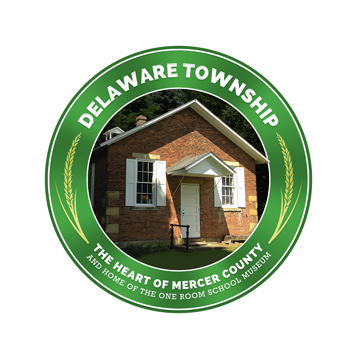The following is an excerpt of the History of Delaware Township, written by Joannie Appleseed in 1976. The complete document is available for download. The document was the property of Richard Hoover, and was donated to the township for posterity.
History of Delaware Township
by Joannie Appleseed
Mercer County, originally known only as the Northwestern Domain of Pennsylvania, later was set aside as land in West Moreland County. From 1788 to 1800, it was part of Allegheny.
Delaware Township (in 1801 – part of Salem; 1802-1805 – Pymatuning Township) was one of the eight townships formed between November 1805 and February 1806.
Delaware was, in 1850, diminished by the laying off of Jefferson Township and a portion was allotted to Hempfield in May 1856.
(Before the Ice Age, 300,000 years ago, all drainage in the county was to the north and west . When the glacial ice melted, the waters could not push through the hills of clay and sand and boulders. Therefore, a new river system, which the Indians called the Shenango — from the Delaware Indian name ockenango translated “big bull thistles” — was born.)
(Earlier inhabitants.-who vanished before the Seneca Nation. principally the Cornplanter Tribe – lived here, left no written records of what they called the area known as Pymatuning — Indian translation: “place where the crooked mouth man or chief with the broken jaw lives”.)
Soldiers of the American Revolution, who came to claim their share of the Donation Lands awarded for military service, were among the first pioneers in Delaware Township, Mercer County.
Others purchased tracts for $20.00 per hundred acres – with the provision they erect a habitation, clear, fence and cultivate at least two acres in each hundred.
Armed only with simple tools, meager provisions, and their trusty rifles, they came on foot or horseback from over the Alleghenies to cut down the virgin forests of pine, poplar, oak, maple, hickory, beech, chestnut, etc.
By firelight in the rude log cabins, they made crude furniture and tools and buckskin boots, they spun and wove and made garments of linsey-woolsey. Sustained by their courage and faith in the Bible, they endured the privations of life in the wilderness where often the nearest neighbors were miles away.
It required great labor to clear the trees, grub and hand-cultivate the land for planting — even small plots of corn and wheat, flax, potatoes, etc. Fences of stumps, stones, and rails were built to keep wild animals from the crops and farm animals.
Nothing was wasted, which could by being saved prevent the expenditure of even a penny.
Descendants of the following families list their forefathers among the first settlers of the township: Caldwell, Homer (also spelled Hemmer, Hammer), Reznor, Williamson, Wasser, Beil, Haas, Donaldson, Kamerer, George, Fruit, Hecker, Black, Stamm and Webster.
